Maritime Security of Ukraine. A Reference Work. (1) The State Border of Ukraine at Sea
Bohdan USTYMENKO,
M.J., Attorney at Law
Tetiana USTYMENKO,
S.J.D., professor,
Department of Civil Law and Procedure
National Academy of Internal Affairs
From the editors of BlackSeaNews
On 7 December 2021, the interdepartmental working group chaired by Secretary of the National Security and Defence Council (NSDC) of Ukraine Oleksiy Danilov completed work on the draft Maritime Security Strategy of Ukraine, a document initiated by President of Ukraine Volodymyr Zelensky.
The strategy was developed taking into account the current experience of the world's leading maritime powers, the positions of maritime law scholars, the proposals of 16 government agencies, independent experts, and business associations. The working group members approved the draft, and the final text of the document, after coordination of some positions, was sent to the President of Ukraine and members of the NSDC of Ukraine.
The strategy took into account a lot of proposals aimed at solving problems that had been repeatedly addressed in the publications by BlackSeaNews authors. Therefore, the editorial board has decided to create a concise and clear reference work based on the contributions from our authors, which looks at the terminology and problems related to maritime security and provides expert explanations.
Contents
(1) The State Border of Ukraine at Sea
(3) The Exclusive Economic Zone and the Continental Shelf
(4) Ukraine's Maritime Borders With Turkey and Romania
(5) Ukraine's Maritime Borders With the Russian Federation
(6) "Historical Waters" of the Sea of Azov and the Kerch Strait
(7) "Internal Waters" and Borders in the Sea of Azov and the Kerch Strait
(8) The Tuzla Island Conflict and the Agreement Under Duress
(11) Foreign Military Exercises in the Exclusive Economic Zone of Ukraine
(12) The Legal Aspects of Hydrocarbon Extraction in the Exclusive Economic Zone of Ukraine
(13) The Prohibition Against Vessels and Ships Entering the 12-Mile Zone of the Crimean Peninsula
(14) Threats of Maritime Formats Involving the Russian Federation
(15) Necessary Legal Measures Ukraine Should Take
* * *
Needless to say, one of the most basic but critical elements of any maritime power is its maritime borders — boundaries that divide the marine spaces (zones) of different states.
The classification offered by Yoshifumi Tanaka, one of the world's leading international maritime law scholars, divides marine spaces into several jurisdiction zones.
According to Tanaka, given the criterion of the national jurisdiction of a coastal state, marine spaces can be therefore divided into two main categories:
- those under national jurisdiction;
- those beyond national jurisdiction.
The first category encompasses internal waters, territorial seas, international straits, archipelagic waters, the contiguous zone, exclusive economic zones and the continental shelf, while the second — the high seas and the Area.
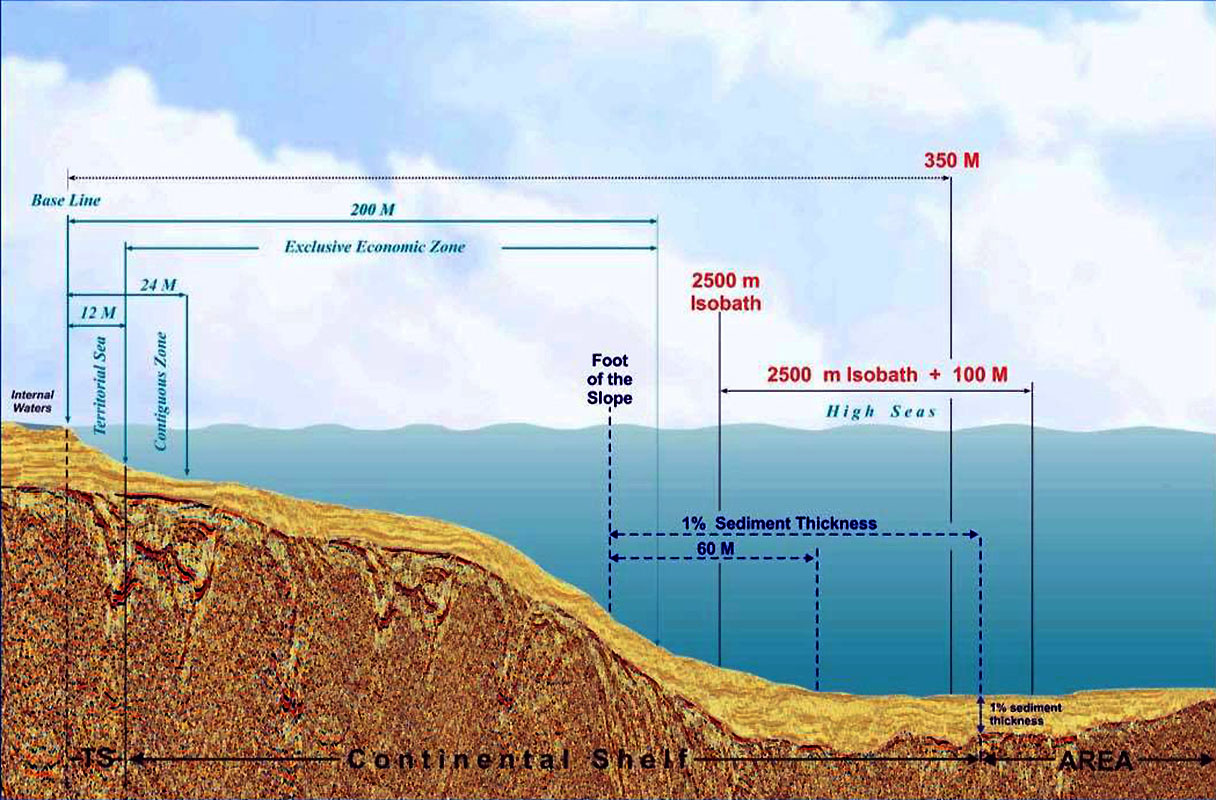
For the purposes of this article, we will closely examine only such marine spaces as the territorial sea, contiguous zone, exclusive economic zone and continental shelf in the context of the so-called Constitution of the Oceans — the United Nations Convention Law on the Law of the Sea (hereinafter — the Convention) and Ukraine’s national legislation. Of all the world’s international instruments, the Convention is second in importance only to the UN Charter and is the foundation of the law of the sea.
For a clearer understanding of the difference between the terms maritime border and state border, let’s consider the decision of the United Nations International Court of Justice (hereinafter — the International Court of Justice) in the case of Romania v Ukraine from February 3, 2009 that will be discussed in more detail later.
In the ruling, the International Court of Justice established that the maritime border separating the continental shelf and exclusive economic zones (EEZ) should not be likened to a national border separating the territories of the states, as the first defines the boundaries of marine zones where under international law, coastal states have some sovereign rights for specific purposes, while the latter defines the territorial boundaries of state sovereignty.
The Territorial Sea
The first marine space (zone) to be considered is the territorial sea.
Article 1 of the Constitution of Ukraine proclaims Ukraine a sovereign independent democratic law-based state;
Article 2 stipulates that the sovereignty of Ukraine extends to its entire territory, which is integral and inviolable within the existing border.
Meanwhile, Article 2 (1) of the Convention establishes that the sovereignty of a coastal state extends beyond its land and internal waters to the adjacent maritime zone, termed the territorial sea.
That sovereignty extends to the airspace above the territorial sea, as well as to its bottom and subsoil.
In addition, Article 3 of the Convention states that each state has the right to set the breadth of its territorial sea to a limit not exceeding twelve nautical miles counted from the baselines defined in accordance with the Convention.
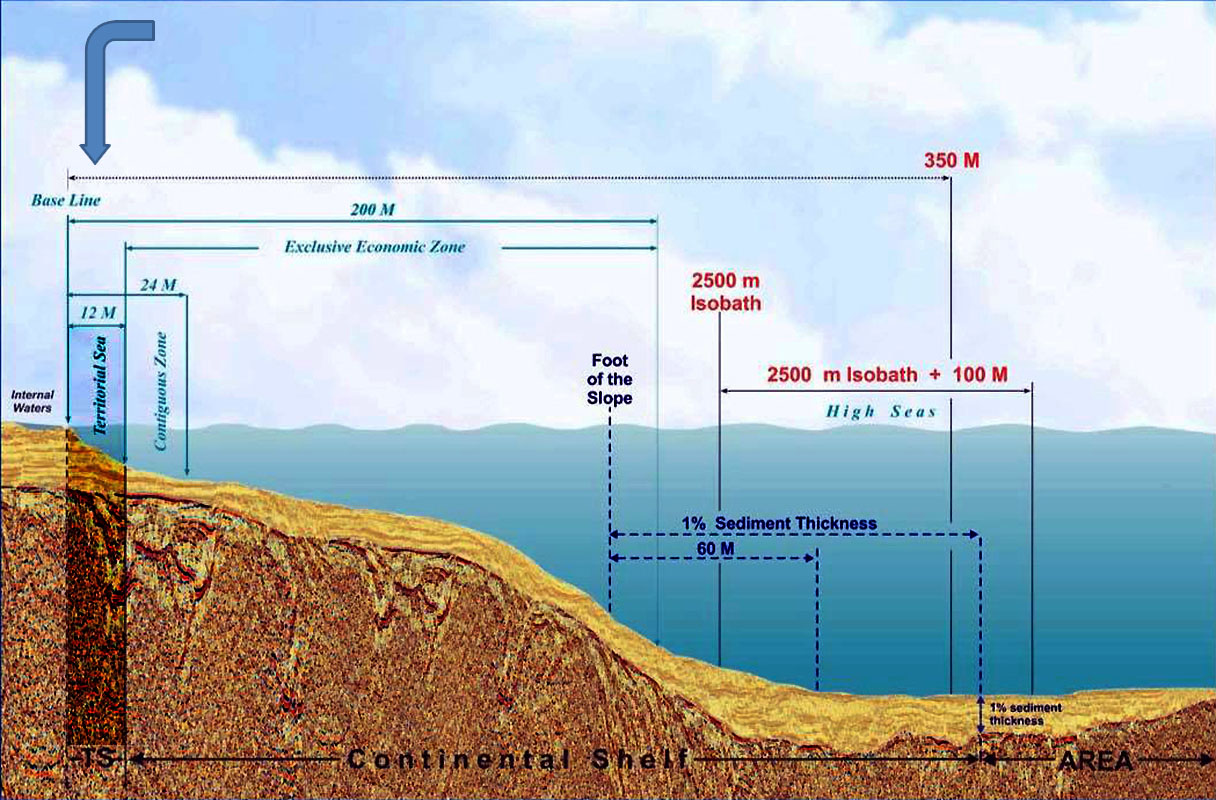
The outer limit of the territorial sea is the line every point of which is at a distance from the nearest point of the baseline equal to the breadth of the territorial sea (Article 4 of the Convention).
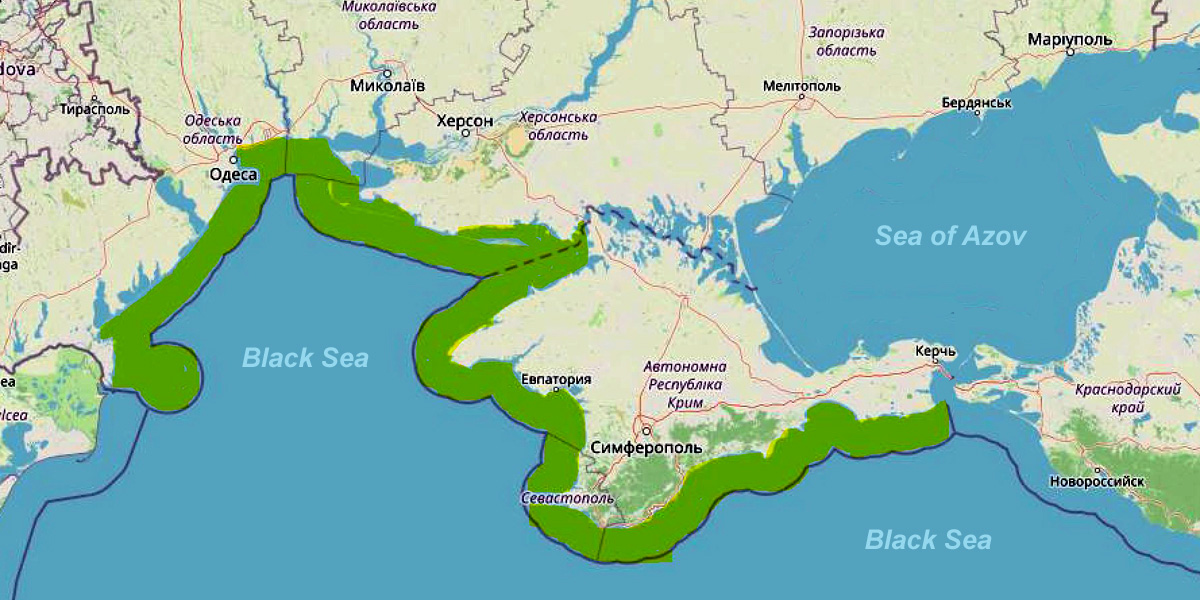
Furthermore, Article 15 of the Convention states that where the coasts of two states are opposite or adjacent to each other, neither of the two states is entitled, failing agreement between them to the contrary, to extend its territorial sea beyond the median line every point of which is equidistant from the nearest points on the baselines from which the breadth of the territorial seas of each of the two states is measured. The above provision does not apply, however, where it is necessary by reason of historic title or other special circumstances to delimit the territorial seas of the two states in a way, which is at variance therewith. However, the above provision shall not apply if, by virtue of historically established legal grounds or other special circumstances, it is necessary to differentiate the territorial seas of the two states in a manner other than that specified in this provision.
The State Border at Sea
At the same time, one must also pay attention to the national legislation concerning the territorial sea of Ukraine. Thus, pursuant to Article 1 of the Law of Ukraine On the State Border of Ukraine (hereinafter — the State Border Law), the state border of Ukraine is a line and a vertical surface that runs along this line that determine the boundaries of the territory of Ukraine on land, water, subsoil and airspace.
The state border of Ukraine is determined by the Constitution and laws of Ukraine, as well as by the international treaties of Ukraine approved by the Verkhovna Rada of Ukraine (Article 2 of the State Border Law).
According to Article 3 of the State Border Law, unless otherwise stipulated by the international treaties of Ukraine, the state border of Ukraine at sea is established on the outer border of the territorial sea of Ukraine.
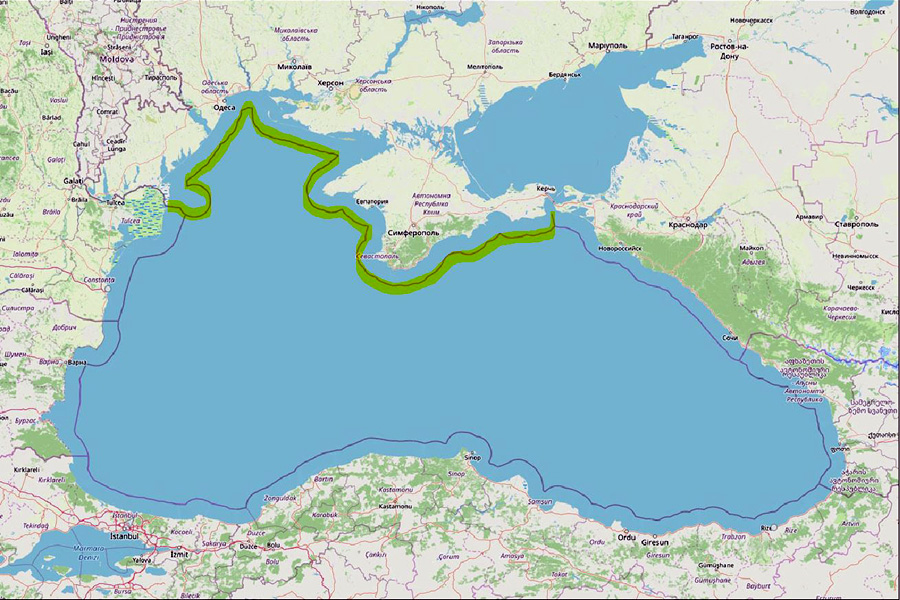
At the same time, Article 5 of the State Border Law states that the territorial sea of Ukraine includes coastal sea waters with a width of twelve nautical miles distinguished from the largest outflow line both on the mainland and in the islands belonging to Ukraine or from direct baselines connecting the corresponding points.
In some cases, Ukraine’s international treaties may establish other breadth of the territorial sea of Ukraine, while in the absence of such treaties, it is set in accordance with the generally recognized principles and rules of international law.
To be continued...
* * *
References:
1. Pro zatverdzhennya Morskoi doktryny Ukrainy na period do 2035 roku: Postanova Cabinetu Ministriv Ukrainy vid 07.10.2009, № 1307. (On Approving the Maritime Doctrine of Ukraine for the Period up to 2035: Resolution of the Cabinet of Ministers of Ukraine from October 7, 2009, #1307). URL: https://zakon.rada.gov.ua/laws/show/1307-2009-%D0%BF.
2. Yoshifumi Tanaka, The International Law of the Sea, third edition (Cambridge University Press, 2019). – p. 554.
3. Konventsiia Organizatsii Ob`yednannykh Natsii z morskogo prava vid 10.12.1982, ratyfikovana Zakonom Ukrainy «Pro ratyfikatsiyu Konventsiia Organizatsii Ob`yednannykh Natsii z morskogo prava 1982 roku ta Ugody pro implementatsiyu Chastyny XI Konventsii Organizatsii Ob`yednannykh Natsii z morskogo prava 1982 roku» № 728-XIV vid 03.06.1999 // Vidomosti Verkhovnoii Rady Ukrainy. – 1999, № 31, stattya 254 (United Nations Convention on the Law of the Sea of December 10, 1982, ratified by the Law of Ukraine "On Ratification of the United Nations Convention on the Law of the Sea of 1982 and the Implementation Agreement for Part XI of the United Nations Convention on the Law of the Sea 1982" # 728-XIV from June 3, 1999, Bulletin of the Verkhovna Rada of Ukraine, 1999, #31, article 254).
4. Кratkoye izlozheniye resheniy, konsultativnykh zaklyuchenii i postanovleniy Mezhdunarodnogo Suda 2008-2012 (Summary of Judgments, Advisory Opinions and Orders of the International Court of Justice 2008-2012), UN, New York, 2014. URL: https://www.icj-cij.org/files/summaries/summaries-2008-2012-ru.pdf - p. 85.
5. Constitutsiya Ukrainy vid 28.06.1996 // Vidomosti Verkhovnoii Rady Ukrainy.- 1996, № 30, stattya 141. (The Constitution of Ukraine of June 28, 1996, Bulletin of the Verkhovna Rada of Ukraine, 1996, #30, article 141).
6. Pro derzhavnyi kordon Ukrainy: Zakon Ukrainy vid 04.11.1991 // Vidomosti Verkhovnoii Rady Ukrainy. - 1992, № 2, stattya 5 (On the State Border of Ukraine: Law of Ukraine of November 4, 1991, Bulletin of the Verkhovna Rada of Ukraine, 1992, #2, Article 5).
7. Pro pryleglu zonu Ukrainy: Zakon Ukrainy vid 06.12.2018 р. / Ofitsiinyi visnyk Ukrainy.- 2019, № 4, stor. 11, stattya 105 (On the Contiguous Zone of Ukraine: Law of Ukraine from December 6, 2018, Official Bulletin of Ukraine, 2019, # 4, p. 11, Article 105).
8. Pro vyklyuchnu morsku (economichnu) zonu: Zakon Ukrainy vid 16.05.1995 р. // Vidomosti Verkhovnoii Rady Ukrainy. - 1995, № 21, stattya 152 (On the Exclusive (Marine) Economic Zone: Law of Ukraine of May 16, 1995, Bulletin of the Verkhovna Rada of Ukraine, 1995, #21, Article 152).
9. Gospodarkyi kodeks Ukrainy від 16.01.2003 // Ofitsiinyi visnyk Ukrainy.- 2003, № 11, stor. 303, stattya 462 (The Economic Code of Ukraine of January 16, 2003 , Official Bulletin of Ukraine, 2003, #11, p. 303, Article 462).
10. Ugoda mizh Uryadom Ukrainy і Uryadom Respubliky Turechchina pro kordon economichnykh (morskykh) zon Ukrainy і Respubliky Turechchina vid 30.05.1994 (Agreement between the Government of Ukraine and the Government of the Republic of Turkey on the Border of Economic (Marine) Zones of Ukraine and the Republic of Turkey of 30 May 1994). URL: https://zakon.rada.gov.ua/laws/show/792_008.
11. Dogovir pro vidnosyny dobrosusidstva і spivrobitnytstva mizh Ukrainoyu ta Rumuniyeyu vid 02.06.1997, ratyfikovanyi 17.07.1997 (Agreement on Good Neighborly Relations and Cooperation betwen Ukraine and Romania of June 2, 1997, ratified on July 17, 1997). URL: https://zakon.rada.gov.ua/laws/show/642_003 .
12. Кratkoye izlozheniye resheniy, konsultativnykh zaklyuchenii i postanovleniy Mezhdunarodnogo Suda 2008-2012 (Summary of Judgments, Advisory Opinions and Orders of the International Court of Justice 2008-2012), UN, New York, 2014. URL: https://www.icj- cij.org/files/summaries/summaries-2008-2012-ru.pdf. – p. 69.
13. Dogovir mizh Ukrainoyu ta Rosiiskoyu Federatsiyeyu pro spivrobitnytstvo u vykorystanni Azovskogo morya і Kerchenskoi protoky vid 24.12.2003 (Agreement Between Ukraine and the Russian Federation on Cooperation in the Use of the Sea of Azov and the Kerch Strait of December 24, 2003). URL: https://zakon.rada.gov.ua/laws/show/643_205.
14. Rozporyadzhennya Prezidenta Ukrainy «Pro vnesennya zmin do Rozporyadzhennya Prezidenta Ukrainy vid 6 zhovntya 1998 roku № 515 «Pro okhoronu derzhavnogo kordonu Ukrainy v Azovskomu ta Chormonu moryakh і Kerchenskyi prototsi ta zabespechennya prav Ukrainy u vyklyuchniy (morskiy) economichniy zoni ta contynentalnomu shelfi u pivnichno-skhidniy chastyni Chornogo morya» vid 6 serpnya 1999 roku № 187/99-rp (Decree of the President of Ukraine On Amendments to the President of Ukraine’s Decree #515 of October 6, 1998 «On Protection of the State Border of Ukraine in the Azov and Black Seas and the Kerch Strait and the Protection of Rights of Ukraine in the Exclusive (Marine) Economic Zone and Continental Shelf in the North-East part of the Black Sea» from August 6, 1999, #187/99-rp). URL: https://zakon.rada.gov.ua/laws/show/187/99-%D1%80%D0%BF.
The article addresses the types of modern Ukraine’s maritime areas in light of the norms of international maritime law and national legislation provisions, and analyzes international documents that establish maritime borders between Ukraine and other coastal states.
The authors propose that Ukraine: 1) promptly commences the compulsory conciliation on Ukraine-Russia maritime border delimitation per Article 298(1)(a)(i) and Annex V, section 2 of the United Nations Convention on the Law of the Sea and 2) adopts the laws on the internal waters and the territorial sea of Ukraine.
* * *
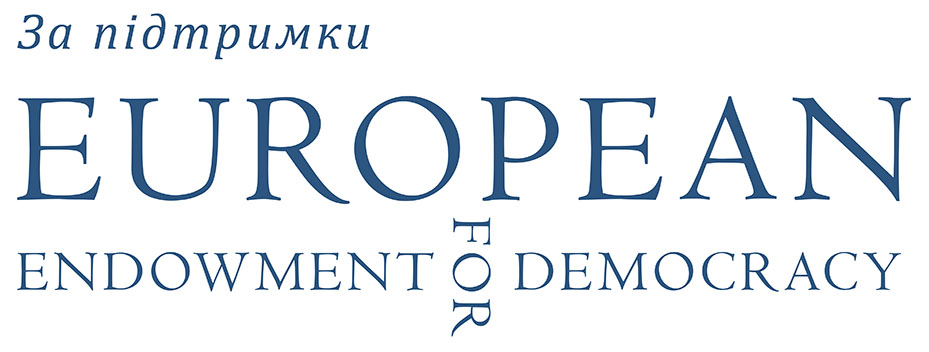 This publication has been produced with the support of the European Endowment for Democracy (EED). Its contents do not necessarily reflect the official opinion of EED. Responsibility for the information and views expressed in this publication lies entirely with the authors.
This publication has been produced with the support of the European Endowment for Democracy (EED). Its contents do not necessarily reflect the official opinion of EED. Responsibility for the information and views expressed in this publication lies entirely with the authors.
More on the topic
- 19.12.2021 Maritime Security of Ukraine. A Reference Work. (15) Necessary Legal Measures Ukraine Should Take
- 19.12.2021 Maritime Security of Ukraine. A Reference Work. (14) Threats of Maritime Formats Involving the Russian Federation
- 19.12.2021 Maritime Security of Ukraine. A Reference Work. (13) The Prohibition Against Vessels and Ships Entering the 12-Mile Zone of the Crimean Peninsula
- 19.12.2021 Maritime Security of Ukraine. A Reference Work. (12) The Legal Aspects of Hydrocarbon Extraction in the Exclusive Economic Zone of Ukraine
- 18.12.2021 Maritime Security of Ukraine. A Reference Work. (11) Foreign Military Exercises in the Exclusive Economic Zone of Ukraine
- 17.12.2021 Maritime Security of Ukraine. A Reference Work. (10) What Mandatory Procedure for the Delimitation of the Maritime Border Between Ukraine and Russia Can Be Adopted
- 16.12.2021 Maritime Security of Ukraine. A Reference Work. (9) The Delimitation of the Sea of Azov and the Kerch Strait According to the UN Convention on the Law of the Sea
- 15.12.2021 Maritime Security of Ukraine. A Reference Work. (8) The Tuzla Island Conflict and the Agreement Under Duress
- 14.12.2021 Maritime Security of Ukraine. A Reference Work. (7) "Internal Waters" and Borders in the Sea of Azov and the Kerch Strait
- 13.12.2021 Maritime Security of Ukraine. A Reference Work. (6) "Historical Waters" of the Sea of Azov and the Kerch Strait
- 12.12.2021 Maritime Security of Ukraine. A Reference Work. (5) Ukraine's Maritime Borders With the Russian Federation
- 11.12.2021 Maritime Security of Ukraine. A Reference Work. (4) Ukraine's Maritime Borders With Turkey and Romania